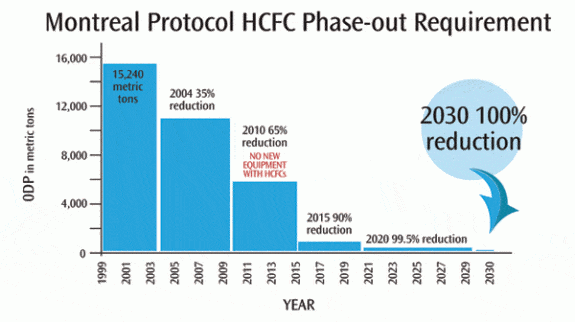Understanding the Price of R22 and Why It’s So High
During the heat of the summer, current and prospective customers should be aware of the continued skyrocketing price of R22 refrigerant (commonly called Freon). This is a result of Environmental Protection Agency (EPA) mandates.
R22: Phase-Out
Such has been the case since especially 2010, but all the way back to 2004. This is when the EPA’s adoption of the Montreal Protocol impacted production of air conditioning systems using R22. As the diagram below shows, the mandatory reduction in supply has been significant since 2010. While R22-based air conditioning systems are no longer manufactured, there are still an estimated 70 million systems in America using air conditioners with R22 refrigerant. You may have one of those systems.

Anyone who’s diagrammed a supply and demand curve knows that with a reduction of supply and a relatively constant demand, prices increase. Suppliers – now charging up to a 1000% increase in R22 to HVAC contractors, like Homesense – has meant pricing of R22 to consumers at $150 to sometimes over $200 per pound. An average AC contains around six pounds of R22, so you can see how prices can quickly skyrocket.
If your system requires additional R22 refrigerant, you may be looking at an incredible price to recharge your system. With many refrigerant leaks requiring as much as 3-4 pounds, you are getting into a price that should prompt you to consider AC installation replacement.
R410A: The Future
Systems are now manufactured to be compatible with a newer refrigerant, R410A (commonly called Puron). As the production of R410A is not regulated, its prices are more reasonable. Unfortunately, R410A is not compatible with systems built for R22. So if your system is older you won’t be able to get these lower prices . If your system is from before 2010, and definitely before 2005, you most likely cannot use R410A. This is where, as we mentioned above, you would find yourself with no choice but to buy the high-priced R22, unless you replace your system.
Our EPA-certified technicians carry both R22 and R410A on their trucks. They can assist you with checking your system’s refrigerant level and giving any recommendations.
Refrigerant 101
Unsure exactly how refrigerant works or when you should be concerned about your system’s refrigerant? Here’s a quick crash course!
Refrigerant works in a closed loop to move heat energy from place to place in your system. While the refrigerant is in your indoor unit (evaporator coil) it removes heat so your home can be cooled. It takes on enough of this heat to change from a liquid to a gas and is pumped outside.
While in your outdoor unit (condenser) the refrigerant releases heat and returns to a liquid. That heat is blown out by the condenser’s fan. The compressor in your outdoor unit then pumps the liquid refrigerant back into the indoor unit and the process starts again.
Since refrigerant exists in a closed loop, it is not “used up” over time. The only reason you could have a refrigerant problem is due to a leak in the system. That may require a recharge of your system’s refrigerant or the replacement of coils.
If you have more questions about the R22 phase-out, pricing, or what you should do with your air conditioning, give us a call (317-203-8149), or reach out online.